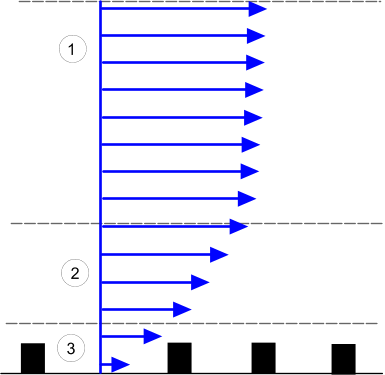Atmospheric Boundary Layers
The Atmospheric Boundary Layer (ABL) is an important part of simulating wind and is used in modeling weather and wind-borne pollution, and in designing wind-farms.
The ABL is the bottom layer of the atmosphere, in contact with the surface of the Earth. Within this layer, features of the surface of the Earth directly affects flow: frictional effects and temperature create turbulence and vertical mixing. Above this layer, rotational effects, rather than turbulence, dominate the flow. The depth of the ABL can vary in both time and space.
Garratt [347] decomposes the boundary layer in the atmosphere of the Earth into two sublayers:
- An outer Ekman sublayer where there is little dependence on the nature of the surface.
- An inner sublayer where surface effects such as friction and heating are important.

| Index | Description |
|---|---|
| 1 | Ekman sublayer |
| 2 & 3 | Inner sublayer |
| 3 | Interfacial sublayer |
Atmospheric boundary layers can be modeled in conjunction with any turbulence model. However, for the Standard K-Epsilon turbulence model, Simcenter STAR-CCM+ provides the Atmospheric Boundary Layer model, which allows you to set inlet boundary profiles according to the Richard and Hoxey Law [349].